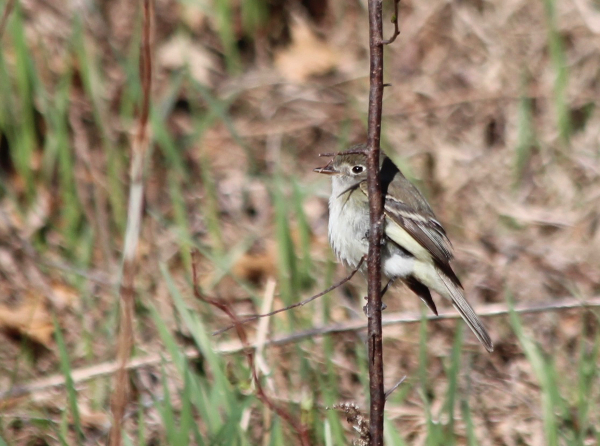Float up, dive down, quick turn, out and back from the twig perch. Graceful, flowing, surprising in their agility as they move through space. This describes the aerial acrobatics of a group of birds that hunt for food “on the fly.”
What are they looking for? Any winged or flying insect that would make a tasty meal.
Aerial insectivores include Common Nighthawks, Whip-poor Wills, Swallows, Purple Martins, Chimney Swifts, and Flycatchers. Some of these are characterized as “Hawkers,” or those that fly and catch their food. (i.e., Tree Swallow). Others are characterized as “Saliers,” or those that perch and “sally forth,” or fly out and come back to the perch (i.e., Flycatchers).
One of the saliers that lives in our area is the Least Flycatcher (Empidonax minimus). The smallest of this genus, the Least Flycatcher is one of the first to arrive in spring. Its song of “Che Bek, Che Bek” is unmistakable and always a joy to hear.
These birds inhabit semi-open deciduous forests as well as shrubby fields and forest edges. They have a bold eye ring, two white wingbars and a very short bill, which is one of the most important identification features.

Like other Flycatchers, they perch in an upright posture on a small twig or branch. Their feeding strategy is to flit out, grab an insect, and go directly back to the perch. You may see them fidget and flick their wings and tail as they wait for the next meal to fly by.
Aerial insectivores are one of the bird groups whose populations are in steep decline. The reasons are not precisely known, but are thought to include loss of insects due to pesticides, the loss of trees and shrubs that surround fields, loss of nesting structures, the loss of habitat in wintering grounds, and something called “phenological mismatch.” This occurs when birds can’t adapt to earlier blossom times and insect emergence dates, which is related to climate change.
All of these birds, as well as bats and dragonflies (also aerial insectivores), provide important ecological services by keeping insect pest populations in check. They also are an important link in the food chain as prey for other species.
The next time you’re out for a walk and see one of these entertaining birds, bats or dragonflies, allow yourself time to pause, watch, and be awed by the skill, grace, and determination of these beautiful members of our natural world community.
To learn more about aerial insectivores, check out the following:
- Rob Diehl’s TED talk: “Airspace as Habitat”
To support aerial insectivores in your area:
- Learn more about these amazing animals by coming to a naturalist-led event at Belwin.
- Read articles and watch videos.
- When you buy your nursery plants, ask what’s in the soil. Neonictenoides are a seed treatment pesticide that negatively affects insects and pollinators.
- Provide a water source in your yard.
- Support local conservancy groups, like Belwin!

